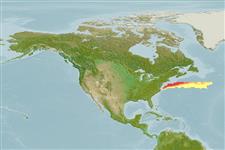Classification / Names
Nombres comunes | Sinónimos | Catalog of Fishes(Género, Especie) | ITIS | CoL | WoRMS | Cloffa
>
Stomiiformes (Lightfishes and dragonfishes) >
Stomiidae (Barbeled dragonfishes) > Melanostomiinae
Etymology: Eustomias: Greek, eu = good + Greek, stoma = mouth (Ref. 45335); jimcraddocki: Named for Dr. James E. Craddock of the Woods Hole Oceanographic Institution in recognition of his many contributions to our knowledge of deep-sea fishes (Ref. 51076).
Environment: milieu / climate zone / depth range / distribution range
Ecología
marino batipelágico; rango de profundidad 0 - 809 m (Ref. 51076). Deep-water; 41°N - 26°N
Northwest Atlantic: known only from slope water south of Georges Bank to the northern Sargasso Sea.
Tamaño / Peso / Age
Maturity: Lm ? range ? - ? cm
Max length : 14.3 cm SL macho / no sexado; (Ref. 51076)
Short description
Claves de identificación | Morfología | Morfometría
Radios blandos dorsales (total) : 24 - 25; Radios blandos anales: 40 - 41. Two pectoral rays (one as tiny rudiment), and a barbel with three branches arising proximal to midlength of the stem, followed by two ovoid swellings (bulbs), either contiguous or separated, and a large terminal bulb. The tear-shaped terminal bulb larger in diameter than the stem or proximal bulbs, with the acuminate end posteriad and upturned dorsally, and bears multiple filaments and bulblets in two groups, one at its anterodorsal surface and one at its terminus. Barbels relatively short (<= 20% standard length) (Ref. 51076).
Probably undergoes some form of vertical migration from below 500 m during the day and within the upper 100 m at night (Ref. 51076).
Life cycle and mating behavior
Maturities | Reproducción | Spawnings | Egg(s) | Fecundities | Larva
Sutton, T.T. and K.E. Hartel, 2004. New species of Eustomias (Teleostei: Stomiidae) from the western north Atlantic, with a review of the subgenus Neostomias. Copeia 2004(1):116-121. (Ref. 51076)
IUCN Red List Status (Ref. 130435)
Threat to humans
Harmless
Human uses
Herramientas
Special reports
Download XML
Fuentes de Internet
Estimates based on models
Preferred temperature (Ref.
123201): 2.9 - 8.8, mean 3.6 °C (based on 14 cells).
Phylogenetic diversity index (Ref.
82804): PD
50 = 0.5000 [Uniqueness, from 0.5 = low to 2.0 = high].
Bayesian length-weight: a=0.00302 (0.00117 - 0.00783), b=3.12 (2.89 - 3.35), in cm total length, based on LWR estimates for this (Sub)family-body shape (Ref.
93245).
Nivel trófico (Ref.
69278): 4.2 ±0.8 se; based on size and trophs of closest relatives
Resiliencia (Ref.
120179): Medio, población duplicada en un tiempo mínimo de 1.4-4.4 años (Assuming tmax>3).
Fishing Vulnerability (Ref.
59153): Low vulnerability (10 of 100).
